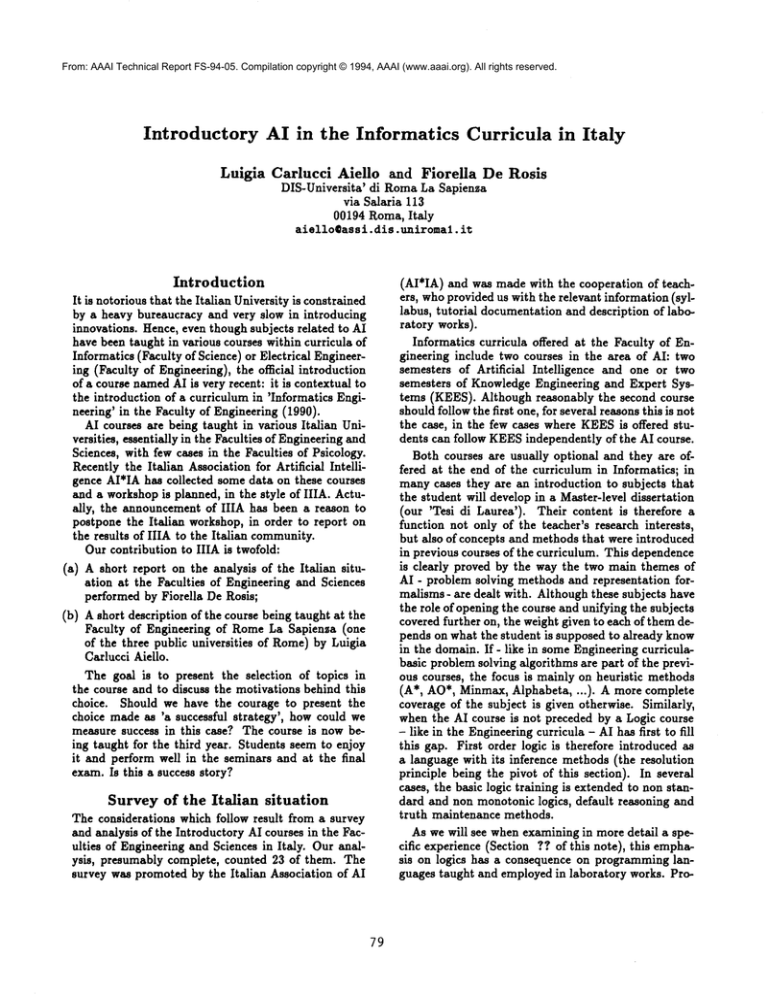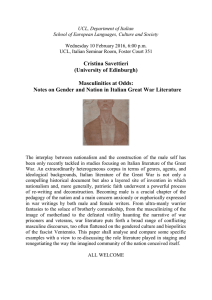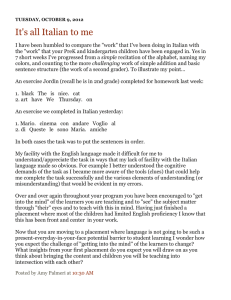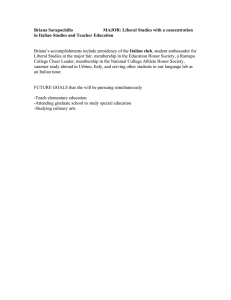
From: AAAI Technical Report FS-94-05. Compilation copyright © 1994, AAAI (www.aaai.org). All rights reserved.
Introductory
Luigia
AI in the Informatics
Curricula in Italy
Carlucci
Aiello
and Fiorella
De Rosis
DIS-Universita’ di RomaLa Sapienza
via Salaria 113
00194 Roma, Italy
aiello@assi,
dis.uniromal,
it
Introduction
It is notorious that the Italian University is constrained
by a heavy bureaucracy and very slow in introducing
innovations. Hence, even though subjects related to AI
have been taught in various courses within curricula of
Inforrnatics (Faculty of Science) or Electrical Engineering (Faculty of Engineering), the official introduction
of a course namedAI is very recent: it is contextual to
the introduction of a curriculum in ’Informatics Engineering’ in the Faculty of Engineering (1990).
AI courses are being taught in various Italian Universifies, essentially in the Faculties of Engineeringand
Sciences, with few cases in the Faculties of Psicology.
Recently the Italian Association for Artificial Intelligence AI*IA has collected some data on these courses
and a workshopis planned, in the style of IIIA. Actually, the announcement of IIIA has been a reason to
postpone the Italian workshop, in order to report on
the results of IIIA to the Italian community.
Our contribution to IIIA is twofold:
(a) A short report on the analysis of the Italian situation at the Faculties of Engineering and Sciences
performed by Fiorella De Rosis;
(b) A short description of the course being taught at the
Faculty of Engineering of RomeLa Sapienza (one
of the three public universities of Rome)by Luigia
Carlucci
Aiello.
Thegoalis to presenttheselection
of topicsin
thecourseandto discuss
themotivations
behindthis
choice.Shouldwe havethe courageto presentthe
choicemadeas ’a successful
strategy’,
howcouldwe
measuresuccessin thiscase?The courseis nowbeingtaughtforthethirdyear.Students
seemto enjoy
it andperformwellin theseminars
andat thefinal
exam.Is thisa success
story?
Survey of the Italian
situation
The considerations which follow result from a survey
and analysis of the Introductory AI courses in the Faculties of Engineering and Sciences in Italy. Our analysis, presumably complete, counted 23 of them. The
survey was promoted by the Italian Association of AI
79
(AI*IA)and wasmadewiththecooperation
of teachers,whoprovided
us withtherelevant
information
(syllabus,
tutorial
documentation
anddescription
of laboratory
works).
Informatics
curricula
offered
at theFaculty
of Engineering
includetwocourses
in theareaof AI:two
semesters
of Artificial
Intelligence
andone or two
semesters
of Knowledge
Engineering
and ExpertSystems(KEES).Althoughreasonably
the secondcourse
should
follow
thefirst
one,forseveral
reasons
thisisnot
thecase,in thefewcaseswhereKEESis offered
studentscanfollowKEESindependently
of theAI course.
Bothcoursesareusually
optional
andtheyareofferedat theendof thecurriculum
in Informatics;
in
manycasestheyarean introduction
to subjects
that
thestudent
willdevelop
in a Master-level
dissertation
(our’Tealdi Lanrea’).
Theircontentis therefore
function
notonlyof theteacher’s
research
interests,
butalsoof concepts
andmethods
thatwereintroduced
in previous
courses
of thecurriculum.
Thisdependence
is clearlyprovedby the way the twomainthemesof
AI - problemsolving
methods
and representation
formalismsaredealtwith.Although
thesesubjects
have
theroleof opening
thecourse
andunifying
thesubjects
covered
further
on,theweight
giventoeachof themdependson whatthestudent
is supposed
to already
know
in the domain. If- like in some Engineering curriculabasic problem solving algorithms are part of the previous courses, the focus is mainly on heuristic methods
(A*, AO*, Minmax, Alphabeta, ...). A more complete
coverage of the subject is given otherwise. Similarly,
when the AI course is not preceded by a Logic course
- like in the Engineeringcurricula - AI has first to fill
this gap. First order logic is therefore introduced as
a language with its inference methods (the resolution
principle being the pivot of this section). In several
cases, the basic logic training is extended to non standard and non monotonic logics, default reasoning and
truth maintenance methods.
As we will see when examining in more detail a specific experience (Section ?? of this note), this emphasis on logics has a consequence on programming languages taught and employed in laboratory works. Pro-
log is the most commonof them, immediately followed
by LISP. Object oriented languages are not common.
Laboratory works tend to privilege programming of
algorithms in these languages rather than the implementation of expert systems by existing shells. In wellstructured experiences, students’ programs are organized in the framework of an incrementally increasing
set of tools which becomeuseful instructional aids.
Subjects of laboratory work are related to more advanced or specialist subjects included in the course.
The most common of them are: Uncertain and Metalevel reasoning, Planning, Learning, Natural Languages and Intelligent Interfaces, Distributed AI and,
more recently, Neural Networks (when they are not
dealt with in separate courses).
Somefinal considerations about textbooks and other
tutorial
documentation. Although the recent years
have seen a flourishing of interests and research activities in the area of AI in Italy there are no italian
textbooks of AI. In addition, no book seems to fully
satisfy expectations of instructors. Therefore, documentation suggested to students is a smorgasbord (to
use this Workshop’sterminology) of selected chapters
from about 50 different books, integrated with articles
from the main journals (Artificial Intelligence, IEEEon
AI-related subjects and so on). The most frequently
adopted books are the following: the Italian translation of Rich and Knight, the Genesereth and Nilsson’s Logical Foundations of AI (the two most popular
ones), Nilsson’s Principles of AI and Jackson, Winston,
Rich, Charniak and McDermott’s textbooks. The consequence of this hetereogeneity of tutorial documentation is that lecturers and their notes have to create a
methodologic continuity among subjects, by unifying
notational differences, filling up gaps, highlighting repetitions of the same subjects in different terms and so
Formalisms and methods
Methods for dealing with non monotonicity,
Truth malntenace, uncertainty, time
3. Automated Deduction Resolution, natural deduction, sequent calculus, semantic tableaux
4. Problem solving; planning
5. Learning
6. Natural Language Understanding
7. Knowledge Engineering and Expert Systems
The emphasis is as follows 1/2 of the time is devoted
to topics 1 to 3 (about forty hours), 1/4 of the time
is devoted to topics 4 and 5 (about twenty hours), 1/4
of the time is devoted to topics 6 and 7 (about twenty
hours).
The main emphasis of the course is Logics as a representation formalism: the programming language chosen for the laboratory work is PROLOG.
Each year a topic is selected and a =specilistic module" is taught on that topic. This module is usually
offered also to post-graduate students. Last year the
selected topic was ’Natural LanguageProcessing’, this
year the topic is ’Representation of structured knowledge and concept description languages’. In addition,
students deepen a particular topic of their choice and
refer on it in a seminar to their colleagues, some of
them participate in a programmmingproject.
The suggested readings are:
1. Ginsberg, Essentials of Artificial Intelligence, Morgan Kanfmann, 1993.
2. Console, Lamina, Mello, Programmazione I, ogica e
Prolog, UTET, 1991
3. Shoam, Arti]icial Intelligence techniques in Prolog,
Morgan Kaufman, 1994.
4. Gonzales, Dankel, The Engineering o/Knowledge
Based Systems, Prentice Hall, 1993.
on.
Some remarks on the course
of AI at
the Faculty
Engineering
of the
University
of Rome ’La Sapienza’.
These books are complemented with chapters from
other books and with articles on specific topics. Lectures are mandatorily in Italian, readings in English
are considered no problem.
The course is nowbeing offered for the third year. It
is placed at the end (5th year) of a curriculum in Informatics Engineering, a mixture of a curriculum in
Electrical Engineering and in ComputerScience, when
students have been exposed to several (mandatory)
courses in programming,data structures, compiler construction, theoretical foundations, operation research,
systems theory, control theory, electronics, etc. Students have usually been exposed to PASCAL,LISP,
PROLOG
and C in previous courses in addition, to
set the context better, it is worth noting that students
are alsop offered a (optional) course of robotics.
Thye syllabus of the AI course is:
1. Introduction: definition, somehistory.
2. Knowledge Representation
80




